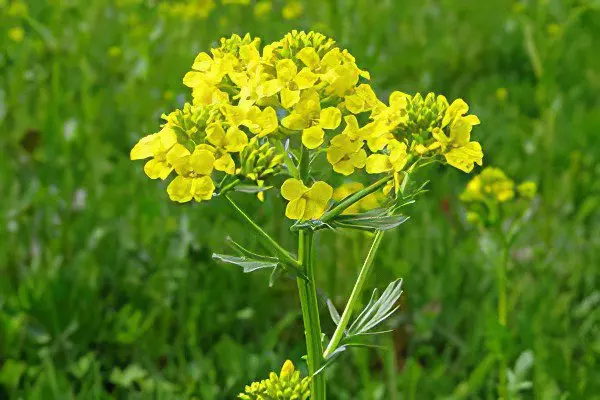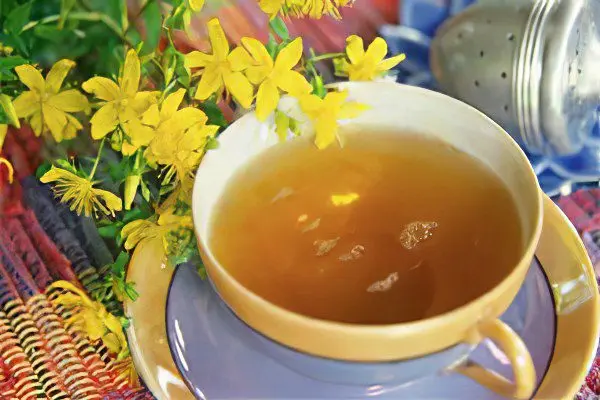Contents
Common colza – a herbaceous plant belonging to the genus Surepka, the Cabbage family. The grass is widespread, grows throughout Europe, is found in Western Siberia, in the European part of Russia, brought to Japan, Africa, Australia and other countries.
In most European countries, this plant is called St. Barbara’s herb.
The plant blooms in spring and in the first month of summer, and bears fruit in mid-June, in July. Fruiting is possible in the second year of the plant’s life. The colza propagates by roots and seeds. Seeds begin to germinate at a temperature of +6 °C. At the same time, only one colza bush is capable of distributing up to 10 seeds into the environment.
It is interesting that in botany there is even a highly specialized section dealing with the study of colza. This section is called surepselia.
What does a colza look like?

The colza is a plant that reaches a height of 80 cm. The grass stalk is most often bare, although sometimes it can be covered with a small fluff. The leaves of the plant are lyre-shaped, the top of the leaf is larger than its lateral parts. The lower leaves are petiolate, the upper leaves are sessile, entire, with serrated edges.
The flowers of the colza are golden yellow, the petals are 7 mm long, the flower itself has 5 stamens, surrounded by four petals. Flowers are located at the top of the plant.
The fruits of the colza are oblong pods, rounded-tetrahedral in shape, seeds are located inside it. Seeds are oval, slightly depressed, almost flat. The color of the seeds is grayish, may be brown. The length of one seed is not more than 3 mm, the width is not more than 1 mm.
Is colza a weed or a medicinal plant?
The bittercress is a weed, but people use it as a medicinal plant.
Useful properties of colza
Useful properties of colza are very diverse:
First, this plant is melliferous. Bees collect a lot of pollen and nectar from it, which the grass reproduces during its flowering. From one hectare of continuous herbage, colza bees bring from 30 to 50 kg of honey. Its aroma is weak, but pleasant, the color is greenish-yellow. It contains a large amount of glucose, so it candied quickly.
Secondly, colza is used in cooking. Soups, side dishes, mashed potatoes are prepared from the green part of the plant. For salads, young grass leaves are excellent, which taste somewhat reminiscent of mustard. However, when including colza leaves in the diet, it should be remembered that the plant can cause poisoning of the body if consumed in large quantities. The herb is very popular in cooking in countries such as Canada and the United States.
Thirdly, some types of plants are used for decorative purposes.
Fourthly, colza is used in medicine for the treatment of various diseases.
Useful properties of seeds, root, flowers and leaves of colza:
Useful properties of plant seeds. The seeds contain substances (thioglycosides) that can fight bacteria. In addition, the same component of the plant has the ability to increase appetite, as it contributes to increased production of gastric juice. Therefore, decoctions and infusions of colza seeds are used to eliminate inflammation and improve appetite. The seeds also contain fatty oils, which are used in industry for the manufacture of bakery products. It is useful to eat such bread for violations in the functioning of the nervous system, with asthenic syndrome.
Useful properties of colza root. Substances that make up the colza root have a diuretic effect and have antiseptic properties. Infusions and decoctions from the root of the plant are used as an aid in infertility, prostatitis, sexual dysfunction, etc.
Useful properties of colza flowers. Colza flowers are able to have a positive effect on the immune system of the body, on the genitourinary and nervous systems of a person. You can collect and dry them for the preparation of useful infusions and decoctions from the beginning of spring to the end of autumn.
Useful properties of colza leaves. In addition to the fact that the leaves of the plant give dishes a piquant spicy taste, they contain vitamin C and other organic acids, which have a positive effect on the functioning of the body as a whole. The juice squeezed from the colza has a wound-healing and disinfecting effect.
Medicinal properties of colza
The medicinal properties of colza are diuretic, wound healing and anti-inflammatory effect. For therapeutic purposes, decoctions and infusions are prepared using various parts of the plant.
Colza for men
The colza for men is a particularly valuable plant, as it helps to deal with such problems as: impotence, prostatitis, impaired sperm production due to hormonal disruptions.
The problem of erectile dysfunction is familiar to many men. This violation of sexual function can occur for a number of reasons: as a result of malnutrition, due to poor environmental conditions in the area of residence, as a result of frequent stress, etc. Therefore, if a man feels that sexual desire is reduced due to weakness, fatigue, colza should be brewed and drink the drink like tea. It increases vitality, gives strength.
A drink based on colza also helps with circulatory disorders. This is possible due to the flavonoids that make up the plant. They help to normalize cholesterol levels, strengthen blood vessels, including the smallest ones. As a result, blood flow to the genitals is normalized, potency is restored.
Quercetin, which is part of the colza, helps to cope with infections that can lead to malfunctions in the process of spermatogenesis. This substance works as an antiseptic, adversely affecting microbes.
As for prostatitis, decoctions and infusions of colza act directly on the cause of this male disease. With the help of herbal medicines, it is possible to strengthen the immune system, help the body in the fight against sexual infections, normalize blood circulation, and make it easier to endure stress and other psycho-emotional stress.
It is important to understand that it will not be possible to get rid of prostatitis by taking exclusively colza-based products. It will be necessary to undergo the treatment prescribed by the doctor in parallel, and use infusions and decoctions as an adjuvant. In addition, a preliminary medical consultation is mandatory.
Turnip for kidney disease
The bittercress in kidney diseases is useful in that it has a diuretic and antiseptic effect. It is known that the kidneys are the main filters in the body, which rid a person of toxins and other harmful substances, removing them with urine. The flavonoids contained in the colza contribute to the expansion of the renal vessels, enhance the filtration of urine. Thus, excess fluid is removed from the body, swelling subsides. In the event that there is a kidney infection, the body will cope with it faster due to the antiseptic components that make up the colza. In turn, ascorbic acid will help strengthen the immune forces.
Recipes for infusions and decoctions of colza

Infusions and decoctions are prepared from all parts of the colza. Before preparing any medicinal product, the plant should be thoroughly washed and dried.
Turmeric-based tincture for normalizing hormonal levels, for the treatment of mastopathy and fibroids. To prepare the tincture, you need to add two tablespoons of dried leaves of the plant to a liter of boiling water and leave to boil for another 20 minutes, after reducing the heat to a minimum. Then pour the resulting composition into a hermetically sealed container and leave for 2 hours. The course of treatment with tincture is 3 months, it should be taken up to 4 times a day, 50 ml at a time.
A tincture based on colza for getting rid of edema, for the treatment of neurotic disorders and epilepsy. Add 4 tablespoons of dried leaves of the plant to a liter of boiling water and leave to boil over low heat for half an hour. Then strain the composition, bring to the original volume and hold for eight hours. The course of treatment is 14 days, it is necessary to take the drug 30 minutes before meals in a volume of 50 ml. For a day you need to drink 200 ml of tincture.
Turmeric-based tincture to relieve pain during urination. In 200 ml of boiling water, add 20 g of the plant (leaves and stems), then turn off the gas and pour the resulting composition into a hermetically sealed container. After two hours, the tincture can be taken in a volume of 50 ml, no more than three times a day after each basic meal.
A colza-based tea that lowers blood pressure and increases vitality. In 300 ml of boiling water, add 2 tablespoons of dried raw materials of the plant (you can take not only leaves, but also stems). After ten minutes of boiling, the product should be allowed to stand for another half an hour. Tea can be drunk in a cup, no more than three times a day.
A recipe based on colza for the treatment of impotence in men. The herb helps with weakened potency and increases the volume of sperm. The crushed raw materials in the amount of 1 tablespoon are brewed with a glass of boiling water, insisted for 3 hours under the lid, filtered and then taken a quarter of a glass four times a day before meals. The duration of treatment is a month. A positive effect can be seen after the first course of therapy.
Colza juice for the treatment of prostatitis and disorders of spermatogenesis. Grind grass, flowers, seeds, plant stems in a blender or pass through a meat grinder, after which the juice must be squeezed out of the resulting mass. It should be drunk 150 ml per day, dividing this volume into three doses, that is, 50 ml at a time. You need to use the remedy after eating. The full course of treatment is 14 days.
Contraindications to the use of colza
Contraindications for colza are as follows:
Blood clotting disorders.
Bladder stones, kidney stones. This is due to the fact that due to the pronounced diuretic effect of colza, the movement of stones can begin, which will lead to blockage of the ureters.
Allergy to the components that make up the colza.
Refuse to take this plant in any form should be during pregnancy and while breastfeeding.
In addition, colza, like other members of the cabbage family, contains mustard oils, which can provoke enteritis and diarrhea. Most of these oils are found in the seeds of the plant, so you need to use them very carefully. It is known that domestic animals often suffer from poisoning if a large amount of seeds of this weed gets into their food.









